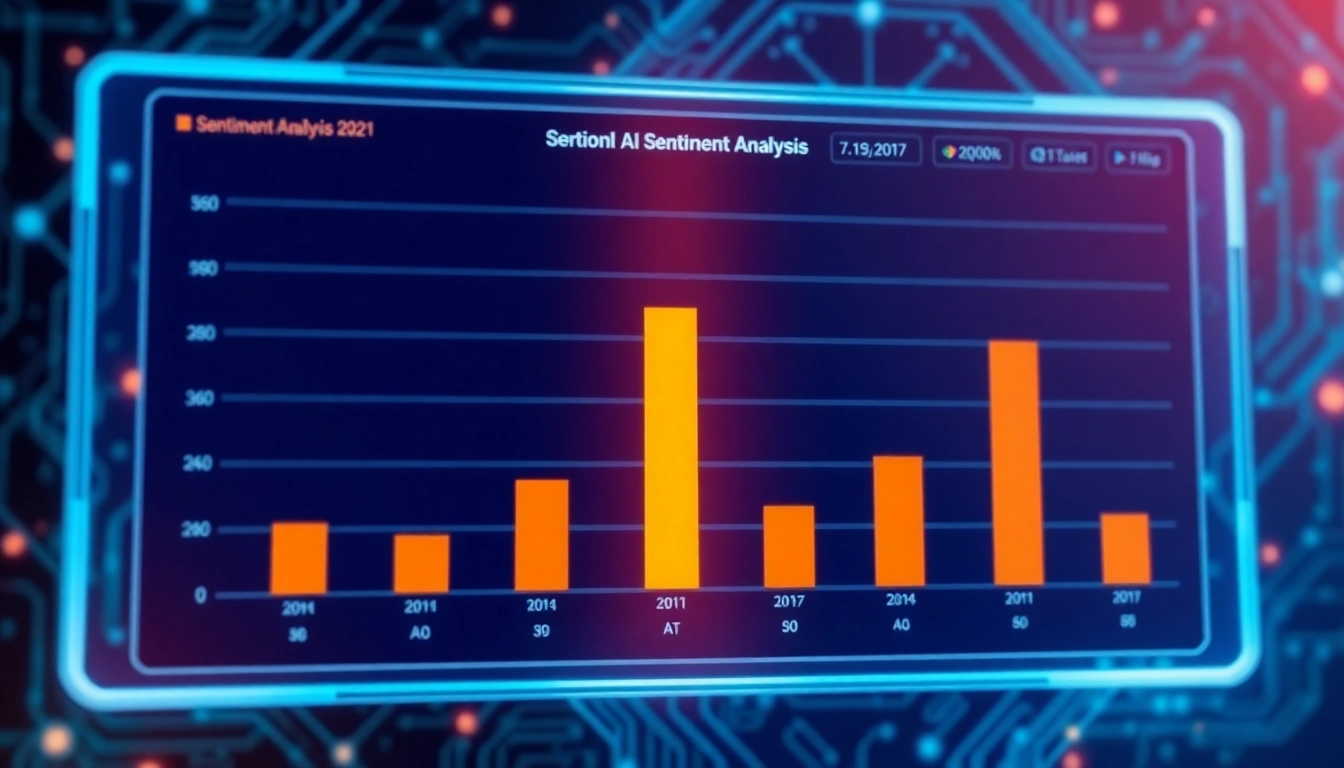Introduction to AI Sentiment Analysis
In our increasingly digital age, understanding consumer sentiment plays a pivotal role in guiding businesses effectively. The evolution of AI sentiment analysis has enabled organizations to tap into the emotions hidden within vast amounts of unstructured textual data. By interpreting this data, businesses can better engage with their customers, enhance brand loyalty, and strategically drive their marketing initiatives. This comprehensive article delves into the intricacies of AI sentiment analysis, its applications, methodologies, and the challenges it faces in providing accurate insights into human emotions.
Definition and Importance
AI sentiment analysis refers to the computational methods and models employed to assess emotional tones in written texts, allowing for an understanding of whether the sentiments expressed are positive, negative, or neutral. This field combines principles from natural language processing (NLP), machine learning, and data mining to analyze textual data derived from various sources such as social media, customer reviews, and more. The importance of AI sentiment analysis lies in its ability to provide actionable insights that inform business decisions and enhance customer relationships.
How AI Transforms Sentiment Analysis
Historically, sentiment analysis was a labor-intensive process that relied heavily on human input. With advancements in artificial intelligence and machine learning algorithms, the process has been revolutionized. AI tools can now analyze sentiment at scale, processing hundreds of thousands of data points in real-time. By utilizing models trained on extensive datasets, these AI systems can detect nuances in language, understand context, and even gauge emotions, leading to more accurate sentiment classifications.
Real-World Applications
The applications of AI sentiment analysis are vast and varied, impacting numerous sectors. For instance, in the marketing and advertising sectors, companies can analyze social media posts to measure the public’s perception of their brand or products. In customer service, AI sentiment analysis enables businesses to gauge customer satisfaction based on feedback and adjust their strategies accordingly. In the finance sector, sentiment analysis can predict stock market trends by analyzing investor sentiment derived from news articles and social media chatter. These applications exemplify how AI sentiment analysis enhances decision-making processes across industries.
Key Components of AI Sentiment Analysis
Natural Language Processing (NLP) Explained
Natural Language Processing (NLP) is a crucial component of AI sentiment analysis, allowing machines to understand, interpret, and generate human language. It involves several subfields, including text analytics, language generation, and speech recognition. Using NLP, sentiment analysis tools can break down large volumes of text into manageable data points, identify keywords and phrases, and assess sentiment based on linguistic cues. NLP employs techniques such as tokenization, stemming, and syntactic parsing, which play significant roles in transforming raw text into meaningful insights.
Machine Learning Algorithms in Sentiment Analysis
Machine learning algorithms are the backbone of AI sentiment analysis, enabling models to learn from data and enhance their predictive capabilities over time. Various algorithms, including supervised learning techniques (e.g., Support Vector Machines, Naive Bayes) and unsupervised learning methods (e.g., clustering), are utilized to categorize sentiment effectively. These algorithms analyze patterns in the data and adjust their parameters based on the training data, leading to more accurate sentiment detection as they encounter new datasets.
Data Sources for Effective Analysis
To achieve high-quality insights, AI sentiment analysis relies on diverse data sources. Commonly used data sources include:
- Social Media: Platforms like Twitter, Facebook, and Instagram provide real-time insights into customer sentiments driven by events, products, or brands.
- Customer Reviews: Websites like Amazon and TripAdvisor contain rich user-generated content that can be analyzed for general sentiment toward products and services.
- Surveys and Feedback Forms: Direct feedback from customers can yield valuable data for sentiment analysis.
- Online Forums and Blogs: Discussions in forums like Reddit can provide insights into specific customer experiences and sentiment trends.
Challenges in AI Sentiment Analysis
Understanding Nuances in Human Emotions
A significant challenge AI sentiment analysis faces is understanding the subtle nuances in human emotions. Human language is inherently complex, filled with idioms, metaphors, and sarcasm, which can confuse even advanced algorithms. For instance, a statement like “What a wonderful day for a wedding” can be seen as genuinely positive or sarcastic based on context. Successfully capturing these nuances requires sophisticated models that can analyze the semantic and contextual elements of language.
Handling Sarcasm and Mixed Sentiments
Many texts express mixed sentiments, where a sentiment may be both positive and negative simultaneously. This complexity requires advanced sentiment analysis techniques that can distinguish multiple emotional tones in a single sentence or passage. Furthermore, sarcasm presents another layer of difficulty, as it often relies heavily on vocal tone and context, both of which are challenging for AI to assess without additional interpretive cues. Advanced deep learning techniques, such as recurrent neural networks (RNNs), and increasingly sophisticated NLP models are being employed to address this challenge.
Data Quality and Integrity Issues
The quality and integrity of the data used in sentiment analysis are paramount. Inaccurate or biased data can lead to misleading results, hence the importance of robust data cleansing techniques. Additionally, outliers or extreme sentiments can skew results, necessitating methods to identify and mitigate these unforeseen impacts. Data preprocessing steps, including tokenization and normalization, are essential to prepare data for meaningful analysis.
Best Practices for Implementing AI Sentiment Analysis
Selecting the Right Tools and Technologies
When implementing AI sentiment analysis, organizations must carefully select the appropriate tools and technologies. Important considerations include the scalability of the technology, ease of integration with existing data systems, and availability of customer support. Brands should also evaluate different AI models to ascertain which one aligns best with their specific needs and objectives. Utilizing open-source libraries like TensorFlow, Scikit-learn, and Hugging Face’s Transformers can accelerate development and deployment of sentiment analysis solutions.
Integrating AI Sentiment Analysis with Business Strategies
AI sentiment analysis should be integrated into business strategy seamlessly to maximize its benefits. This integration allows organizations to proactively respond to customer feedback, enhance product offerings, and tailor marketing strategies based on sentiment data. For effective integration, organizations can establish a feedback loop where sentiment analysis systems continuously inform product development and marketing strategies.
Measuring Success: Key Performance Indicators
To gauge the effectiveness of AI sentiment analysis, businesses must establish clear key performance indicators (KPIs). These may include:
- Sentiment Score: An aggregated score reflecting the overall sentiment derived from the analysis.
- Customer Satisfaction Ratings: Often correlated with sentiment data, these ratings can indicate overall success.
- Engagement Metrics: Tracking how customers engage with content based on sentiment can reveal the impact of various campaigns.
- Market Trends: Monitoring how sentiment translates into market trends can guide future strategic decisions.
Future Trends in AI Sentiment Analysis
Innovations in Sentiment Analysis Technology
As technology continues to evolve, so does the field of AI sentiment analysis. Innovations such as the use of transformer models, which focus on context and attention mechanisms, are reshaping how sentiment is analyzed. These models allow AI systems to process large amounts of data quickly while considering contextual relationships. Innovations also extend toward combining sentiment analysis with other AI branches, such as voice recognition and computer vision, for a more comprehensive understanding of customer sentiment.
The Role of Big Data and AI
The vast volumes of data generated daily present both challenges and opportunities for AI sentiment analysis. Big data analytics facilitate the processing of immense datasets, enabling organizations to derive richer insights from their sentiment analysis efforts. The convergence of big data and AI further enhances the capacity to predict trends and respond swiftly to customer needs, fostering a more agile and responsive business environment.
Ethical Considerations in Sentiment Analysis
As AI sentiment analysis becomes more prevalent, ethical considerations surrounding data privacy and bias must be addressed. Organizations must ensure that they handle customer data responsibly, obtaining consent where necessary. Additionally, efforts should be made to prevent algorithmic bias, as it could reinforce existing stereotypes or discriminate against specific groups. By prioritizing transparency and ethical data practices, organizations can build trust with their customers while leveraging AI sentiment analysis for business growth.









